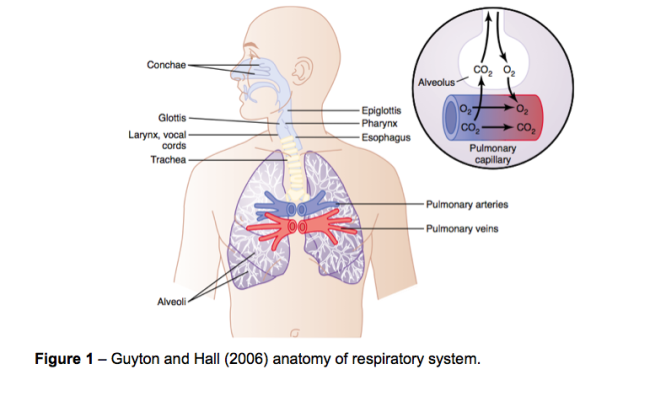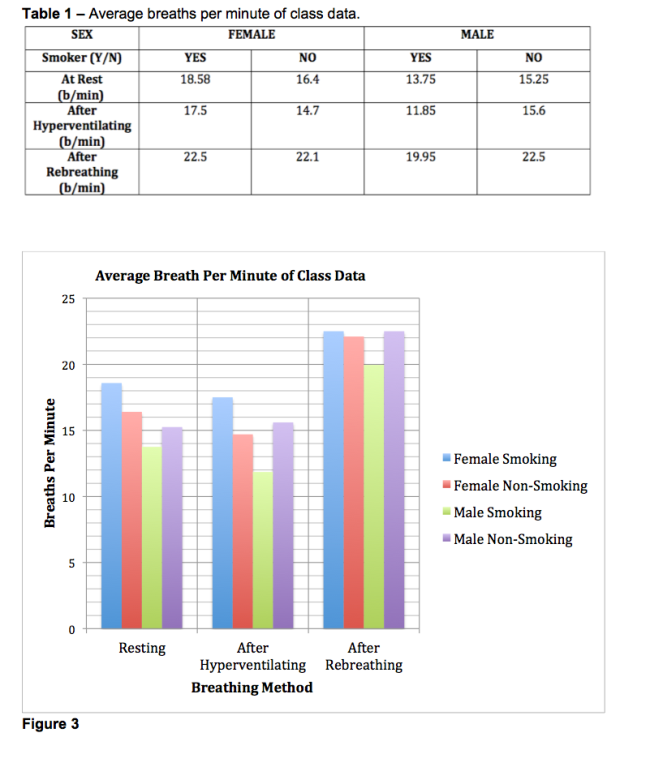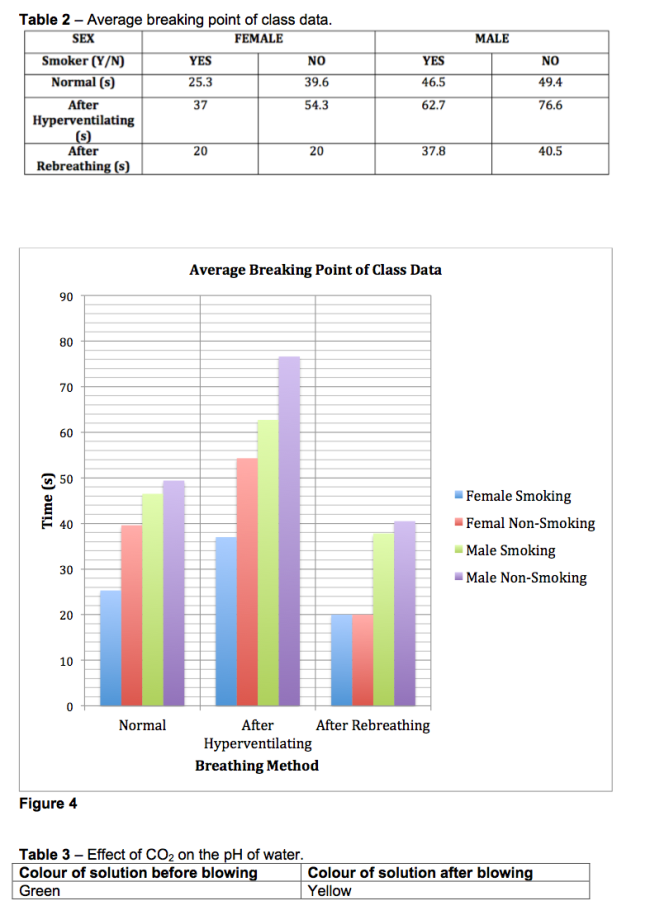INTRODUCTION
The aim of practical 3 under the respiratory control subsection was to investigate the effects that hyperventilation and rebreathing have on ventilation rate and breaking point and to observe the effect of carbon dioxide (CO2) on water pH (School of Science and Health 2012). The results from respiration rate and breaking point were then compared to the different sexes and further with those whom identified as being a smoker or non-smoker.
Parks (2006) says that the breakpoint (measured in seconds) is a strong involuntary physiological mechanism that will supersede voluntary apnea (breath holding) and force the individual to breathe again. Respiration rate is the number of breaths taken per minute. Hyperventilation as define by Martini, Ober and Nath (2011) is when the respiration rate and depth of respiration is greater than the required demand for oxygen delivery and removal of carbon dioxide is. Rebreathing as defined by Oxford Dictionaries (2012) is catching and re-inhaling exhaled air.
Gold et al. (1996) said that there is little known regarding difference in respiratory function between males and females. Their study however suggested that adolescent females may be more susceptible to the effects of smoking which may affect growth of function. It is commonly known that smoking generally decreases respiratory efficiency and has been proven for example by Lindstrom (2001) to increase the prevalence of disease such as bronchitis.
The respiratory system as stated by Tortora and Derrickson (2012)
“contributes to homeostasis by providing for the exchange of gases- oxygen and carbon dioxide-between the atmospheric air, blood, and tissue cells. It also helps adjust the pH of body fluids.”
Figure 1 from Guyton and Hall (2006) above shows an anatomical outline of the essential components of the respiratory system. The relationship between structure and function is an integral component to understand the physiology of the respiratory system.
Layman (2004) explains the physiology of the respiratory system as follows. O2 diffuses through the alveolar sacs into the blood stream where it binds to the ‘heme’ group in within haemoglobin (Hb) molecules. Four oxygen molecules can bind with the four ‘heme’ groups present in the haemoglobin molecule forming oxyhaemoglobin (HbO2).
Similarly as red blood cells circulate O2 throughout the body; they also play a vital role in removing CO2 which is produced during cellular respiration. CO2 has limited solubility in blood plasma much like O2 therefore the majority of CO2 (90-93%) diffuses into red blood cells. CO2 is then transported via two different methods:
1. Combining with haemoglobin: CO2 binds with the amino group in haemoglobin forming carbaminoglobin (HbCO2). Once the red blood cells are close to the pulmonary alveoli, the CO2 breaks off from the haemoglobin and diffuses into the alveoli and is exhaled.
2. Combining with water: around 70% of CO2 diffuses into the red blood cells after cellular respiration and combines with the water within the red blood cells with the aid of carbonic anhydrase; and enzyme that speeds up the binding of CO2 with water. The reaction can be summarised into the following equation:
CO2 +H2O⇌H2CO3 ⇌H+ +HCO3-
The bicarbonate (HCO3-) ion is soluble in plasma and can therefore be immediately diffuse out of the red blood cells into the blood plasma and transported to the pulmonary capillaries. Once here the bicarbonate ion re-enters the red blood cell and the reaction is reversed converting HCO3- back into CO2 and expelled.
The major stimulus that causes inspiration is attributed to the increase in CO2 concentration and H+ ions (increasing acidity) in blood. Normoventilation (normal breathing – state of acid-base balance) is desired by the body. That is, the correct levels of O2 and CO2 are present in the body. Any deviation from normoventilation is referred to as hypoventilation (too much CO2 build up due to slow breathing) and hyperventilation (too little CO2 in the body due to excessive breathing).
Excessive build-up of CO2 is the causing agent for breaking point. When one holds their breath it is hypothesised by Parkes (2005) that chemo- and proprioreceptor afferent activity of the diaphragm cause the discomfort of breath holding. Breath holding can be influenced by a variety of physiological phenomena further explained in Parkes (2005) paper ‘Breath-holding and its breakpoint’.
pH can be measured in a variety of ways. In this experiment bromothymol blue was used as an indicator. Figure 2 shows the colour change of bromothymol blue at specific pH levels.
MATERIALS AND METHODS
To conclude the effect of hyperventilating on breaths per minute partner two observed partner one at rest for 60 seconds time with a clock at rest to determine resting breaths per minute. Partner one was left to read a portion of text to ensure they did not influence their breathing consciously. This was repeated to determine partner two’s resting breaths per minute and recorded. Partner one then hyperventilated for 30 seconds timed with a clock. After the partner counted the number of breaths taken in 60 seconds immediately after hyperventilating by observing chest movement. The result was recorded and the procedure was repeated with partner two and recorded.
To determine the effect of rebreathing on breaths per minute, a completely intact paper bag (no tears or punctures) was breathed in and out of for as long as comfortable for partner one ensuring no air leaks. Once rebreathing had ceased, partner two immediately determined the breaths per minute of partner one in 60 seconds using a clock to time. The procedure was repeated for partner two and results were recorded.
Individuals determined their respective breaking point at rest in seconds. Partner one determined breaking point at rest by holding their breath (voluntary apnea) and timing the duration until the individual must breath again. Partner two also repeated this. The duration of voluntary apnea was timed with a clock and recorded. Both partners hyperventilated for 30 seconds, commenced timing, held their breath and recorded breaking point. Finally, partners re-breathed for as long as comfortable and then held their breath, commenced timing and recorded the time at breaking point.
To observe the effects of CO2 on pH a beaker was half filled with water and a few drops of bromothymol blue. The initial colour of the water was recorded. Wearing safety glasses; a straw was used to blow softly into the beaker containing solution for several full breaths. The colour after was then recorded.
RESULTS
DISCUSSION
The results from table 3 indicate through the bromothymol blue turning from green to yellow indicate that CO2 when in water has acidic properties. The reaction
can be expressed as:
CO2(aq) + H2O(l) ⇌ H+(aq) + HCO3–(aq)
Table 1 and figure 3 data presents an anomaly as to what would be expected in the results. Male’s whom identified as smokers presented a lower average number of resting breaths per minute. This may be attributed to error in measurement or the
lower number of smoking participants to study.
Another abnormality in the data to what would be expected that is presented in table 1 is the fact that the average non-smoking males number of breaths per minute increased while other categories decreased. It is expected that breaths per minute would decrease after hyperventilating, as a state of homeostasis will have been achieved in regards to concentrations of O2 and CO2 in the blood. Having the lower levels of carbon dioxide will result in less stimuli triggering the diaphragm to contract and forcing inhalation. This abnormality in the non-smoking males may be attributed to voluntary respiration. After concentrating on hyperventilating and counting breaths per minute immediately after, breathing rates may not have been entirely physiologically controlled. After rebreathing the results showed a positive correlation with the theory. That is, the increase in CO2 concentration in the blood in the form of carbonic acid would stimulate a greater respiration rate to restore homeostasis and ensure a normal pH level of blood is present. A number of factors may have attributed to the differences in resting breaths per minute.
Respiration rate is influenced by CO2 and O2 levels in the blood, blood pH, drugs and alcohol and cerebral cortical input (manual control of breath) Andrews (2011). Any altering of these conditions may be reasoning for difference in results. It is expected that smokers will have a higher respiration rate due to the decreased efficiency of their
respiratory system due to damage from smoking.
The average breaking point of individuals showed in table 2 and figure 4 shows males having a longer average breaking point than females. Although there is no distinct physiological differences between the male and female respiratory system, the longer period may be due to males having an on average larger lung capacity. Smokers had shorter breaking points, which can again be attributed to the lack of efficiency of the respiratory system in comparison to those of non-smokers. After hyperventilating it was a general trend that breaking point time increased quite significantly between the different groups. This is again due to homeostasis being achieved and having the optimal concentrations of CO2 and O2 in the blood. Rebreathing significantly decreased the breaking point time due to the increase in concentration of CO2. The body will have been stimulated strongly to commence breathing due to the low pH in the blood to prevent respiratory alkalosis as described by Layman (2004).
REFERENCES
ANDREWS, T. 2011. Factors that Affect Respiration Rate [Online]. Available: http://www.livestrong.com/article/108342-factors-affect-respiration-rate/ [Accessed 2012].
GOLD, D., R, WANG, X, WYPIJ, D, SPEIZER, F, E 1996. Effects of Cigarette smoking on lung function in adolescent boys and girls. The New England Journal of Medicine, 335, 931-937.
GUYTON, A., C, HALL, J, E 2006. Text Book of Medical Physiology, Philadelphia, Elsevier Inc.
LAYMAN, D. 2004. Physiology Demystified, McGraw Hill.
LINDSTROM, M., KOTANIEMI, J, JONSSON, E, LUNDBACK, B 2001. A
Comparative Study Between Northern Sweden and Northern Finland: Report From the FinEsS Study. Smoking, Respiratory Symptoms, and Diseases, 119, 852-861.
MATINI, F., H, OBER, W, C, NATH, J, L ET AL. 2011. Visual Anatomy and Physiology, San Francisco, Pearson Education.
PARKES, M. J. 2006. Breath-holding and its breakpoint. Experimental Physiology, 91, 1-15.
PILLAR, S 2012, 300818 Introduction to Physiology 300818 at The University of Western Sydney, Campbelltown.
School of Science and Health 2012, 300818 Introduction to Physiology, practical manual 3, University of Western Sydney, Campbelltown
SENESE, F. 2001. Acid-Base Indicator [Online]. General Chemistry Online Available: http://antoine.frostburg.edu/chem/senese/101/acidbase/indicators.shtml [Accessed 2012].
TORTORA, G., J, DERRICKSON, B 2012. Principals of Anatomy and Physiology, Hoboken, John Wiley and Sons, Inc.





This is absolutely great!! Do you know what mark you got for this assignment? 😀
High Distinction – cannot recall the specific mark but it was in the low mid 90’s.